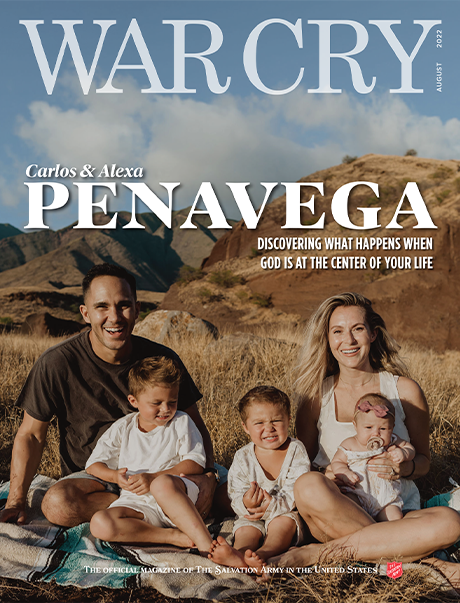An Awareness of God’s Presence
Not only are we all invited into God’s presence but as bearers of God’s presence, we are invited to leave the shelter of the Tabernacle and carry His presence into a world that desperately needs it.
Have you ever felt like a certain place helped you experience God’s presence more clearly? Maybe it’s a special chair where you read the Bible every morning. Or a certain part of the sanctuary where you worship every Sunday. Or maybe even a place along a nature trail where God’s beauty shines. For ancient Israel, the place they experienced God’s presence was the Most Holy Place. This was the center of God’s presence on earth. By understanding how God was present in the Most Holy Place, we can understand how God desires to be present with us today. Though there is no more physical Tabernacle with a Most Holy Place, He still desires to be present with His people.
The Ark of the Covenant
The Most Holy Place was a room 15 feet by 15 feet with a 15-foot ceiling, housing a single piece of furniture: the Ark of the Covenant. The Ark of the Covenant was essentially a box with a lid. The lid included the representation of two cherubim facing each other with an empty spot between them. This empty spot above the Ark was the focus of God’s presence. Exodus 25:22 says, “I will meet with you there and talk to you from above the atonement cover between the gold cherubim that hover over the Ark of the Covenant. From there I will give you my commands for the people of Israel.”
No expense was spared on the Ark. It was covered in gold, inside and outside. The Ark was not God, and it did not represent God’s form, but it symbolized His power and presence. The Ark was only viewed once per year on the Day of Atonement and only by one person, the high priest. After several days of preparation and several steps of washing and sacrificing, fully adorned in all his special garments, he would enter the Most Holy Place and sprinkle the blood of the ram representing the sin of the nation. The cover itself was called the mercy seat. By following all regulations and by sprinkling the blood, the high priest would find mercy—forgiveness from sin for all the people.
Hebrews 9:4 tells us that three items were placed inside the Ark: stone tablets of the covenant, a jar of manna and Aaron’s rod. These were all important artifacts of God’s working with His people that solidify the relationship He wanted to have with them.
Stone Tablets of the Covenant
These stone tablets listed the principles that would govern the lives of God’s people. It listed not only the 10 commandments, but the whole law which describes how to live a holy and consecrated life for God. No one was ever able to keep the whole law. As this covenant was broken between God and His people over and over, year after year, the high priest would come in to sprinkle the blood as an offering for the role of the people in breaking the covenant. God never broke His end but His people did.
Jesus was the fulfilment of the Law. He did keep the covenant — the whole law — perfectly. His life didn’t look like what the Pharisees thought the perfect life should look like. Jesus knew and lived out the law from His heart—loving the Lord God with all His heart, soul, mind and strength and loving His neighbor as Himself.
The Jar of Manna
The next item in the box was the golden jar of manna. This reminded God’s people of His mighty acts of provision. When the Israelites were wandering in the desert and had no food, God provided miraculously for their needs. Every morning the Israelites would wake up and find manna on the ground. It tasted like wafers with honey. They could gather just as much as they needed and the rest would melt away. The jar of manna is a reminder that the relationship between God and His people is founded on concrete acts of love and provision. They provide a basis for the relationship and should not be forgotten.
Aaron’s Rod
The final item in the box was Aaron’s rod. There was a time when the Israelites rejected Aaron’s leadership and wanted to choose someone else. They didn’t trust Moses’ word so God told Moses to have each of the leaders of the tribes lay their staff in front of the Ark. He left them there overnight and in the morning Aaron’s staff had not only sprouted but had budded, blossomed and produced almonds.
A walking stick, disconnected from a tree and stripped of its bark, had not only shown life but budded, blossomed and produced almonds! This was God’s sign that Aaron was chosen to represent the people before God. He was God’s chosen priest despite his shortcomings!
Living Arks
God’s presence is no longer limited to the Most Holy Place. Thanks to Jesus’ death on the cross, His resurrection, and the gift of the Holy Spirit, we are invited to be bearers of God’s presence in the world. We might even consider ourselves “living Arks” as we carry the promises and reminders inside of us just like the items in the former Ark.
We carry the law of loving God and loving our neighbor. Jeremiah prophesied that the law would not always be limited to stone tablets but would be written on hearts: “I will put my instructions deep within them, and I will write them on their hearts. I will be their God, and they will be my people” (Jeremiah 31:33).
Though we don’t have daily manna, we are reminded by Jesus of God’s ongoing provision for our lives in Matthew 6:31-33 — “So don’t worry about these things, saying, ‘What will we eat? What will we drink? What will we wear?’ These things dominate the thoughts of unbelievers, but your heavenly Father already knows all your needs. Seek the Kingdom of God above all else, and live righteously, and he will give you everything you need.”
The staff in the Ark represents the hope of life after death: the hope of resurrection. 1 Peter 1:3 says, “Praise be to the God and Father of our Lord Jesus Christ! In his great mercy he has given us new birth into a living hope through the resurrection of Jesus Christ from the dead…” (NIV)
As we live our lives according to God’s principles, trusting God for our needs, and affirming the hope of resurrection, we carry with us the presence of God. Scripture reminds us that God is ALWAYS with us. But sometimes, His presence manifests in powerful ways. People describe feeling God’s presence like an urge to cry, a burning in one’s heart, trembling in our bodies, a whooshing sound in our ears, or even unexplained goosebumps. God’s presence brings mercy to the atmosphere. That may display itself in healing, comfort, forgiveness, or an overwhelming sense of love.
Scripture tells us that the veil between the Holy Place and the Most Holy Place was torn from top to bottom in the moment that Jesus died. Not only are we all invited into God’s presence but as bearers of God’s presence, we are invited to leave the shelter of the Tabernacle and carry His presence into a world that desperately needs it.
Questions to consider
- How have you experienced God’s presence?
- Is living according to God’s principles, trusting Him for your needs, or affirming the hope of the resurrection most difficult for you to bear?
- Where does God want you to take His presence?







